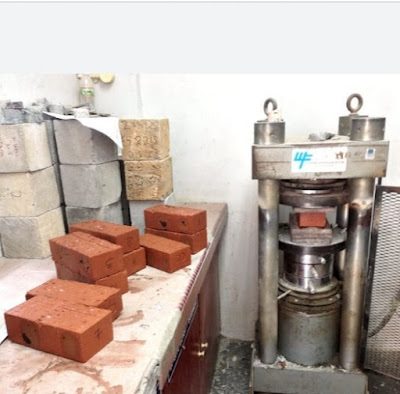- Get link
- X
- Other Apps
- Get link
- X
- Other Apps
Compressive Strength Test on Bricks and its importance
Hello friends, today in this post you will learn the easy methods in which you learn : "How to check quality of bricks on site".
So, please read the post completely. After reading the post, you will completely understand the simple tests to check the quality of bricks on site.
Also, for your reference below I'm sharing the video releated woth this post.
So, let's start with these amazing topic...
So, please read the post completely. After reading the post, you will completely understand the simple tests to check the quality of bricks on site.
Also, for your reference below I'm sharing the video releated woth this post.
So, let's start with these amazing topic...
What is Compressive strength?
The Compressive strength of bricks, determines the load-carrying capacity of a material.
The Compressive strength test on bricks is performed in a lab & requires a specific apparatus to conduct the test.
Compressive Strength of Bricks:
It is the capacity of brick to resist or withstand under compression, when tested on Compressive testing machine [CTM].
It is the ability of the material to resist failure in the form of cracks and fissure.
In this test, the compression force is applied on both the faces of brick as well as the maximum compression that brick can bear without cracking is observed & recorded.
Classification of Bricks based on Compressive Strength:
As per the IS code : 1077-1992 bricks are classified into 11 different types based on Compressive strength of a bricks.
In Below table, the Compressive strength of Brick of different classes are mentioned below :
The Bricks can be easily classified while selecting the right brick , the bricks are classified as :
- First Class Brick : The bricks having a compressive strength of 10 N/mm2 is called as a First class bricks.
- Second Class Brick : The brick with compressive strength of 7 N/mm2 is called as a Second class brick
- Building brick : The brick which we use for building has a compressive strength of 3.5 N/mm2
- Sundried Brick : The sun dried brick has a compressive strength of 1.5 N/mm2 to 2.5N/mm2.
Compressive Strength test on Bricks:
Apparatus :
1.Compressive testing machine [CTM],
2.Three samples of bricks,
3.Cement mortar of ratio 1 : 1 (1 Part of cement as well as 1 part of sand), Plywood sheets & trowel to fill the mortar in the brick frog is required.
Precautions:
- The sampling of bricks should be done carefully & the dimensions of bricks should be measured near to 1 mm
- We have to ensure the three bricks have the same & equal size.
- Bricks having no efflorescence are choosen for the test,
- Clean water is used for test.
Procedure:
- For the test, we have to choose Three bricks which are free from any uneveness.
- After that, we have to Immerse these brick samples in the water for 24 hours at the temperature of 23 Degree Celsius.
- In this step, we have to now Prepare the mortar by mixing the cement as well as the sand at the ratio of 1:1.
- Now, we have to Fill the frog with the mortar paste. After these we have to allow it, to set the bricks in jute bags for the period of 24hrs.
- We have to check for the voids on the brick surface. If there any voids present, we have to fill the voids by flushing the mortar on them.
- Take out the bricks from bags, after that we have to immerse them back in the water for 7 days to complete the hardening of mortar on brick.
- In last, we should Allow the bricks to dry, before placing it on the CTM machine.
- Remember that, we have to Place the specimen in flat-wise on the base of CTM, with the mortar filled face upwards between the two flat plywood sheets.
- In these, we have to use thePlywood sheets to hold the brick in the correct position while testing.
- Start the CTM and apply the load axially on the specimen at the rate of 14 N/mm2 per minute till the brick starts breaking.
- Repeat the same procedure with the leftover bricks
- We have to start, Observing the reading of each brick from CTM, once the brick starts tearing.
Observations :
Contact Area (Top face Area) = …………….mm2
Max Load at which the specimen (brick) starts breaking = ……………….N
Formula to calculate the Compressive strength :
Compressive Strength = Max load at which Specimen starts breaking (N) / Contact area (mm2)
The Standard size of brick is 190mm x 90mm x 90mm
Area = Length x width = 190×90 = 17,100 Sq.mm.
Suppose the max load at which the Brick starts cracking = 600 KN
As per formulae,
Compressive strength of calculated bricks = 600×100 / 17100 = 35N/mm2
The same procedure is adopted and the average value is calculated.
Important notes :
According to the I.S, at least three bricks are tested at 7 days as well as the average of the three bricks are rounded to nearest 0.5N/mm2.
Do not consider the specimen which differs more than 10% of the average value of compressive strength.
For easy understanding of test, take reference of below video for easy understanding :
Video 1 :
Video 2 :
Thankyou friends for reading my Blog. I hope you definitely like these bolg.
For such new Blog releated updates, subscribe to our website. Thankyou.







Comments